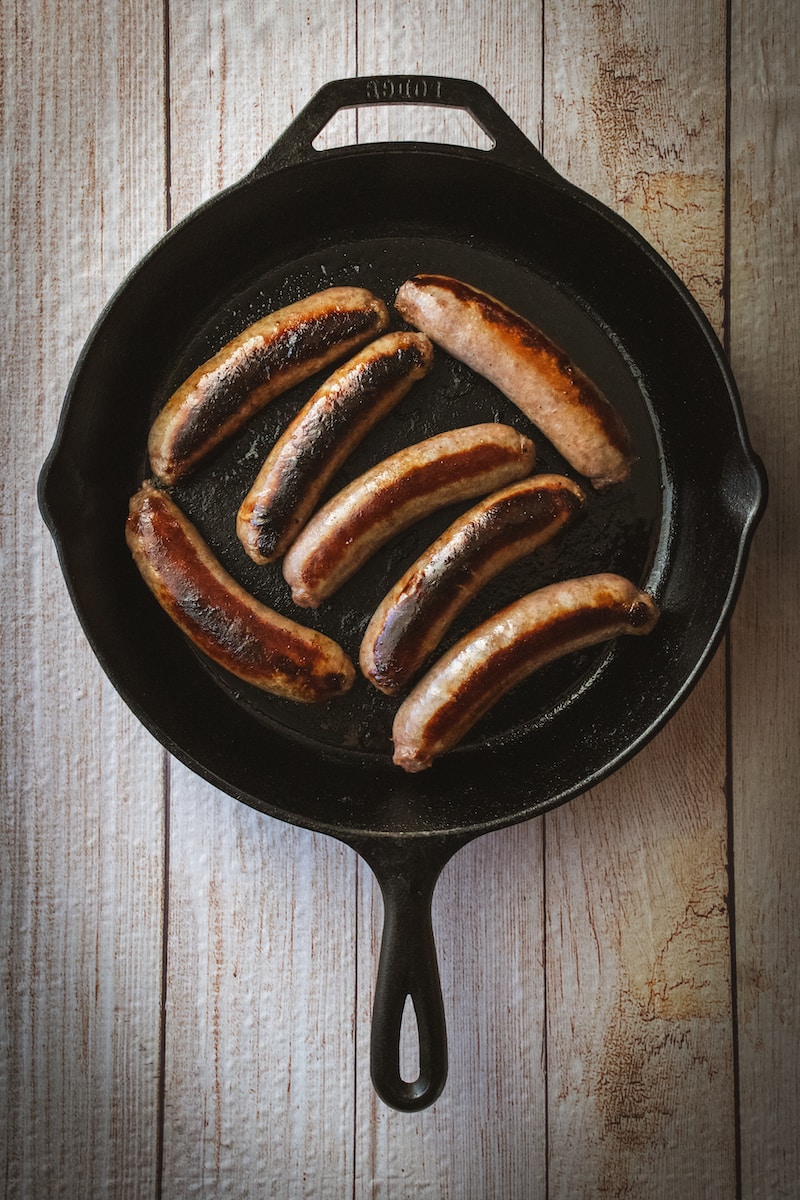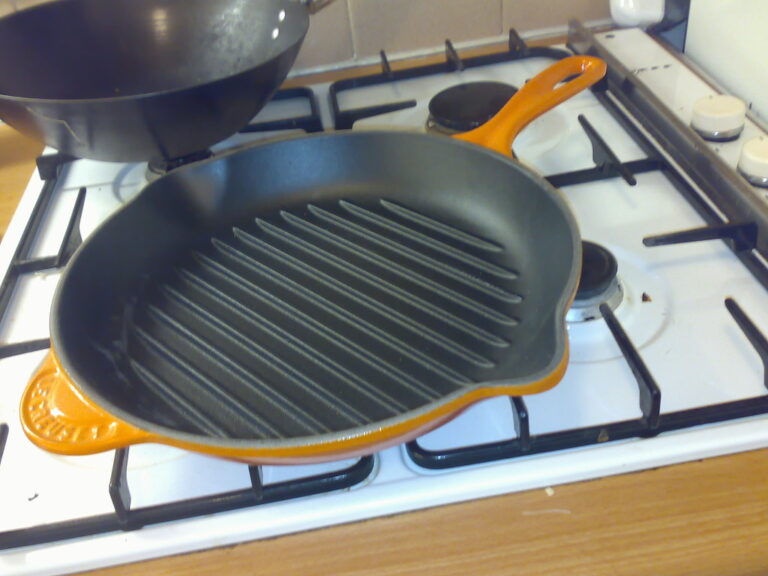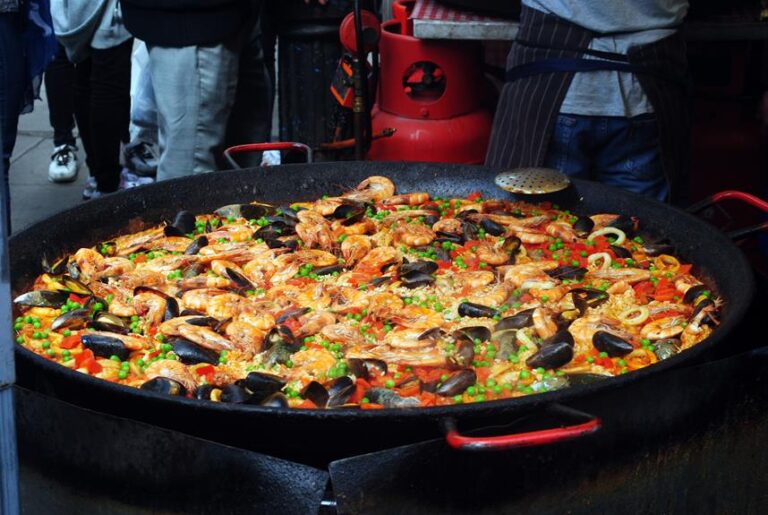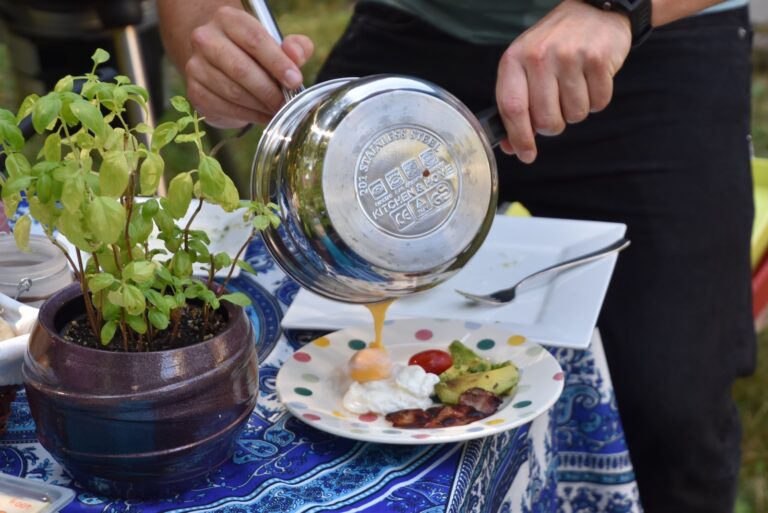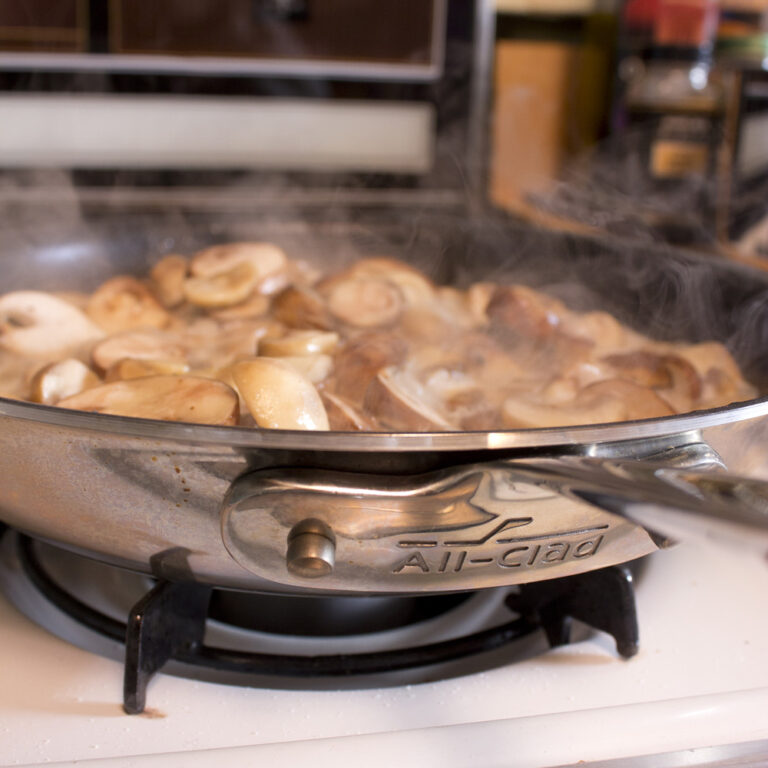I absolutely love using cast iron cookware in my kitchen. It’s incredibly durable, retains heat like a champ, and is so versatile. Plus, its natural non-stick properties make cooking a breeze.
Not to mention the health benefits of cooking with iron. Of course, there are a few downsides, like the weight and maintenance. However, considering its affordability and compatibility with various stovetops, I still think cast iron cookware is a great investment for any home cook.
Key Takeaways
- Excellent heat retention and distribution
- Natural non-stick surface with proper seasoning
- Adds enhanced flavors to dishes
- Durable and long-lasting
Durability
I’ve found that cast iron cookware is incredibly durable and can withstand high temperatures. Its durability is one of the main reasons why I love using it in my kitchen.
Unlike other types of cookware that can easily chip or break, cast iron is built to last. I’ve accidentally dropped my cast iron skillet multiple times, and it has never suffered any damage.
Additionally, cast iron cookware requires very little maintenance. I simply wash it with warm water and a gentle scrub brush, and then dry it thoroughly to prevent rusting. Occasionally, I season it with a thin layer of oil to maintain its non-stick surface.
Overall, the durability and low maintenance of cast iron cookware make it a reliable and long-lasting addition to any kitchen.
Heat Retention
When it comes to heat retention, cast iron cookware truly shines.
I love how efficiently it distributes heat, ensuring that my food cooks evenly and thoroughly.
Plus, it retains warmth for longer periods of time, allowing me to serve piping hot dishes even after they’ve been taken off the stove.
Efficient Heat Distribution
The even heat distribution of cast iron cookware is one of its greatest advantages. When I cook with my cast iron skillet, I know that every part of the food will be cooked evenly. It ensures that the flavors are perfectly blended and the textures are just right. Here are some reasons why the efficient heat distribution of cast iron is so beneficial:
- Retains heat for a long time, keeping the food warm even after removing it from the stove.
- Allows for precise temperature control, making it ideal for searing meats or simmering delicate sauces.
- Distributes heat evenly across the entire cooking surface, eliminating hot spots and preventing uneven cooking.
- Provides consistent results every time, ensuring that your dishes turn out delicious and perfectly cooked.
- Helps save energy by requiring less heat to cook, making it an eco-friendly choice.
Cleaning and maintaining cast iron cookware is also relatively easy. With a little care, it can last a lifetime.
Versatile Cooking Temperatures
One of the reasons I love using my cast iron skillet is because it allows me to easily switch between different cooking temperatures. The versatility of temperature control in cast iron cookware is unmatched.
Whether I want to sear a steak on high heat or simmer a delicate sauce on low, my cast iron skillet can handle it all. This flexibility is essential for various cooking techniques, such as sautéing, frying, or even baking.
The ability to adjust the heat quickly and accurately gives me complete control over the outcome of my dishes. It ensures that my food is cooked evenly and to perfection every time.
The reliable temperature control is one of the many reasons why cast iron cookware is a staple in my kitchen.

Retains Warmth Longer
I love how my cast iron skillet retains warmth longer, keeping my food hot for a longer period of time. It’s one of the reasons why I prefer using it over other cookware options.
Here are some benefits of its exceptional heat retention:
- Even cooking: The cast iron’s ability to retain heat evenly ensures that my food is cooked thoroughly and consistently.
- Energy efficiency: Because it retains warmth so well, I can lower the heat on my stove, saving energy and reducing my utility bills.
- Versatility: From searing steaks to baking cornbread, my cast iron skillet can handle it all, thanks to its excellent heat retention.
- Long-lasting warmth: When I serve meals in my cast iron skillet, I know that the food will stay hot until everyone is ready to eat.
- Cooking efficiency: The prolonged warmth allows me to multitask in the kitchen, preparing other components of the meal without worrying about my food getting cold.
Overall, I appreciate the cooking efficiency that my cast iron skillet offers, thanks to its ability to retain warmth for extended periods of time.
Versatility
I love how versatile cast iron cookware is for cooking a wide variety of dishes. The beauty of cast iron lies in its ability to handle different cooking techniques and offer endless recipe options.
Whether I’m searing a steak, simmering a stew, or baking a skillet cookie, cast iron delivers consistent heat distribution and retention. Its ability to withstand high temperatures makes it perfect for techniques like frying, sautéing, and braising.
The non-stick surface that develops over time allows for easy flipping and turning of delicate foods. I can enjoy the crispy edges of a frittata or perfectly seared scallops without worry.
From breakfast to dinner, cast iron cookware is my go-to for creating delicious and versatile meals.
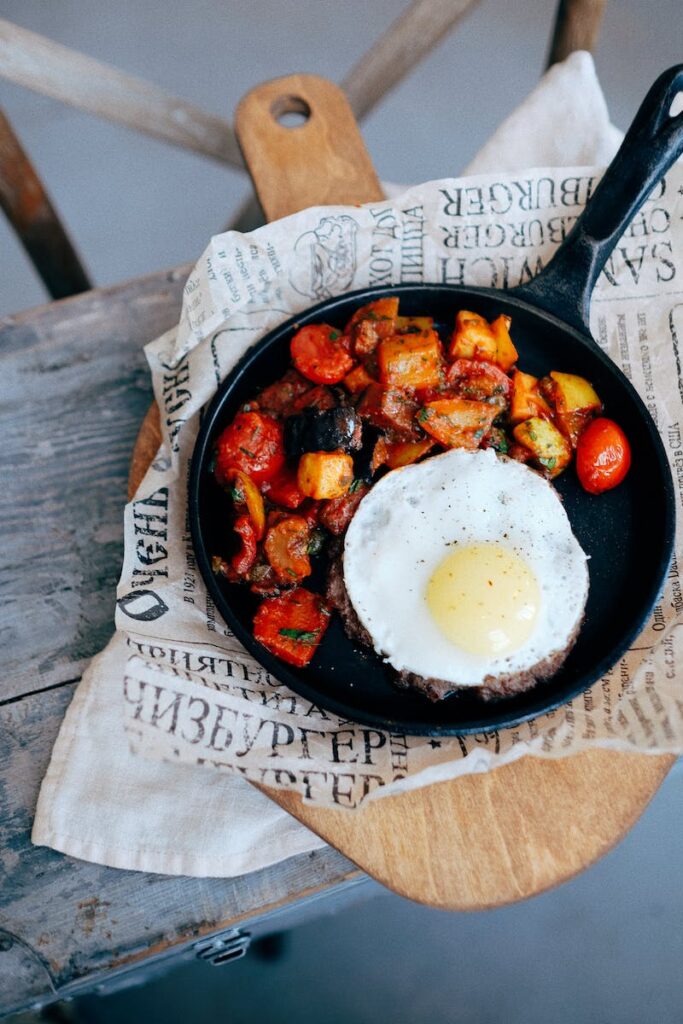
Natural Non-Stick Properties
The natural non-stick properties of cast iron make cooking and cleaning a breeze. When I use my cast iron skillet, I never have to worry about food sticking to the surface. It’s like magic!
Here are some reasons why cast iron is the best:
- Natural Seasoning: Over time, cast iron develops a natural seasoning that enhances its non-stick properties. This means that the more I use it, the better it gets at preventing food from sticking.
- Even Heat Distribution: Cast iron is known for its ability to distribute heat evenly. This ensures that my food cooks consistently and prevents any hot spots.
- Versatility: I can use my cast iron cookware on the stovetop, in the oven, or even over a campfire. It’s incredibly versatile and can handle high heat without warping.
- Durability: Cast iron is built to last. With proper care, it can be passed down for generations, making it a sustainable choice.
- Easy to Clean: Cleaning my cast iron is a breeze. I simply wipe it clean with a paper towel or rinse it with hot water, and it’s good to go.
Overall, the natural non-stick properties of cast iron, along with its even heat distribution, make it a must-have in any kitchen.
Health Benefits
Cooking with cast iron provides a healthier alternative to non-stick cookware. The health benefits of using cast iron are numerous. Firstly, it adds iron to your diet. As the food cooks in the cast iron skillet, it absorbs some of the iron, which is then transferred to your body. This is especially beneficial for individuals with iron deficiencies.
Additionally, cooking with cast iron requires less oil or fat, making it a healthier cooking option.
As for cleaning methods, it’s important to avoid using harsh detergents and abrasive scrubbers that can damage the seasoned surface of the cast iron. Instead, I prefer using a gentle scrub brush and hot water to clean my cast iron cookware. This preserves the seasoning and ensures that the health benefits of using cast iron are maintained.
Cooking Performance
When it comes to cooking performance, cast iron cookware truly shines. I love using my cast iron skillet because it allows me to experiment with various cooking techniques and achieve incredible results.
Here are some reasons why cast iron excels in cooking performance:
- Even heat distribution: Cast iron retains and distributes heat evenly, ensuring that your food cooks consistently and thoroughly.
- Versatility: From searing steaks to baking cornbread, cast iron can handle it all. It’s perfect for stove-to-oven cooking.
- Long-lasting heat: Once heated, cast iron maintains its temperature, making it ideal for dishes that require steady and prolonged heat.
- Non-stick surface: With proper seasoning, cast iron develops a natural non-stick surface, reducing the need for excessive oil or butter.
- Enhanced flavors: The seasoning process adds a depth of flavor to your dishes, making them even more delicious.
Overall, the cooking performance of cast iron cookware is exceptional, making it a staple in my kitchen.
Maintenance and Care
I find that taking care of my cast iron skillet is essential for maintaining its quality and longevity. There are a few maintenance tips and cleaning methods that I follow to ensure my skillet stays in top shape.
Firstly, after each use, I make sure to clean it immediately, using only hot water and a stiff brush or sponge. Avoid using soap, as it can strip away the skillet’s seasoning.
Once clean, I dry it thoroughly and apply a thin layer of vegetable oil to prevent rusting.
Another important maintenance tip is to avoid soaking the skillet in water for too long, as this can also lead to rust.
Lastly, I store my skillet in a dry place, away from moisture, to further protect it.
Weight and Handling
Handling my skillet can be a bit challenging due to its weight, but I find that using both hands and a firm grip makes it much easier to maneuver. When it comes to weight considerations and handling techniques, here are some things to keep in mind:
- Distribute the weight evenly by holding the handle and supporting the base.
- Use oven mitts or a towel to protect your hands from the heat.
- Avoid lifting the skillet with one hand, as it can strain your wrist and make it harder to control.
- Be mindful of your surroundings and make sure you’ve enough space to move the skillet safely.
- Take breaks if needed, especially when cooking for extended periods, to avoid fatigue.
Price and Affordability
I’m always mindful of the price and affordability when purchasing kitchen equipment. When it comes to cast iron cookware, I believe it’s important to consider the price in relation to its long term investment value.
While cast iron cookware may initially seem more expensive compared to other types of cookware, it is actually a cost-effective choice in the long run. To illustrate this, let’s take a look at a price comparison table:
| Cookware Type | Price Range |
|---|---|
| Cast Iron | $50 – $200 |
| Non-Stick | $20 – $100 |
| Stainless Steel | $30 – $150 |
| Copper | $100 – $300 |
| Aluminum | $15 – $80 |
As you can see, the initial price of cast iron cookware may be higher, but it offers durability and longevity, making it a worthwhile long term investment.

Compatibility With Various Stovetops
When it comes to compatibility with various stovetops, I’ve found that cast iron cookware works well on both gas and electric stoves. The sturdy construction and even heat distribution make it a reliable choice for any type of stovetop.
Additionally, I’ve learned that cast iron isn’t recommended for use on induction cooktops due to its lack of magnetic properties.
Stovetop Compatibility: Gas Vs Electric
I find that cast iron cookware works well on both gas and electric stovetops. It’s versatile and can handle the heat distribution of both types of stoves effectively.
Here are some key points to consider when comparing gas and electric stovetops for cast iron cooking:
Gas Stovetops:
- Instant and Precise Heat Control: Gas stovetops offer immediate and precise heat control, allowing for quick adjustments during cooking.
- Even Heat Distribution: They distribute heat evenly across the entire surface of the cookware, promoting uniform cooking.
- Quick Temperature Adjustments: Users can swiftly adjust temperatures during cooking, providing flexibility in the cooking process.
- Higher Flame Setting: Achieving desired heat levels may require a higher flame setting, a characteristic of gas stovetops.
- Intense and Direct Heat: The nature of gas stovetops can result in more intense and direct heat on the bottom of the cookware.
Electric Stovetops:
- Slower Heat Response: Electric stovetops have a slower heat response compared to gas, requiring some time to reach the desired temperature.
- Consistent and Even Heating: Once heated, electric stovetops provide consistent and even heating across the entire cookware surface.
- Preheating Requirement: Preheating is necessary to achieve the optimal cooking temperature on electric stovetops.
- Hot Spots: Some electric stovetops may have hot spots due to the positioning of heating elements.
- Slower Cooling Down: After removing the cookware, electric stovetops may have a slower cooling down time compared to gas counterparts.
Overall, both gas and electric stovetops can work well with cast iron cookware, but it’s important to understand their heat distribution characteristics to achieve the best cooking results.
Induction Cooktop Considerations
I’ve found that induction cooktops are a great option for their precise and fast heat control. Not only do they provide instant and accurate temperature adjustments, but they also offer energy efficiency.
Induction cooktops use magnetic fields to directly heat the induction cookware, rather than heating the entire cooking surface. This means less energy is wasted and more heat is transferred to the pot or pan.
Induction cookware is specifically designed to work with induction cooktops, and it features a magnetic base that creates a strong connection with the cooktop’s magnetic field. This ensures efficient heat transfer and reduces cooking time.
Overall, the combination of induction cooktops and induction cookware makes for a highly efficient and effective cooking experience.
Glass-Top Stove Concerns
The glass-top stove has been a concern for me because of its delicate surface that can easily get scratched or cracked. However, I’ve found ways to use my cast iron cookware safely on this type of stove.
Here are some tips that have helped me navigate the world of glass-top stove compatibility:
- Use a smooth-bottomed cast iron pan to prevent scratching the glass surface.
- Avoid dragging the pan across the stove; instead, lift and place it gently.
- Preheat the pan slowly to ensure even heat distribution on glass top stoves.
- Use low to medium heat settings to prevent overheating and potential damage.
- Allow the pan to cool completely before cleaning to avoid thermal shock.
Conclusion
After considering the pros and cons of cast iron cookware, it’s clear that it offers numerous advantages.
Its durability, heat retention, versatility, natural non-stick properties, health benefits, and compatibility with various stovetops make it a great choice for any kitchen.
While it may require a bit of extra maintenance and care, the benefits far outweigh the drawbacks.
Furthermore, with its affordable price and long-lasting nature, investing in cast iron cookware is definitely worth it.
